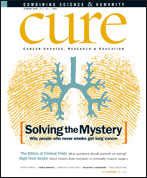Publication
Article
CURE
Laying the Foundation for Better Bone Health
Author(s):
Protecting bone health in childhood cancer survivors.
Typical in patients with metastatic disease or bone cancer, reduced bone health because of cancer or its treatment is a well-known side effect. Now researchers are discovering childhood cancer patients may also have a higher risk of weakened bones and osteoporosis later on in life. A report published in the April 1 issue of Cancer described how treatments such as radiation and certain types of chemotherapy increase these risks for young cancer patients.
Because bone tissue is in constant flux with cells that build up bone tissue, called osteoblasts, and cells that tear it down, called osteoclasts, this delicate balance can be easily disrupted. Much of a person’s bone mass accumulates in adolescence and lays the foundation for future bone health. If the body can’t reach its peak bone mass during this time, it can lead to greater health problems later in life.
Previous studies have found that childhood cancer survivors have a greater risk of reduced bone mineral density. One small study published last year found that osteopenia, a precursor to osteoporosis, was found in two-thirds of brain tumor and acute lymphoblastic leukemia patients treated with radiation to the head compared with 27 percent of patients who did not have radiation. The latest results of the Childhood Cancer Survivor Study, which followed 10,000 childhood cancer survivors treated in the 1970s and 1980s, show many survivors are at risk for chronic illnesses, but osteoporosis may be an under-reported late effect.
Therapies proven to impact bone tissue include corticosteroids and methotrexate, as well as radiation to the head, which can cause reduced growth hormone secretion. Reduced physical activity, which is common in survivors undergoing active treatment, further contributes to bone loss as well as nutritional deficiencies. Certain cancers, such as acute lymphoblastic leukemia, brain cancer, bone cancer, and lymphomas also cause bone loss.
Authors of the Cancer report, Alessandra Sala, MD, PhD, and Ronald D. Barr, MD, both of McMaster University in Hamilton, Ontario, call for greater importance to be placed on physical exercise in these patients to help build bone mineral density, as well as meeting dietary intake of vitamin D and calcium. Drs. Sala and Barr also recommend using bisphosphonates, a class of drugs that strengthen bone by inhibiting the ability of osteoclasts to break down bone tissue, while increasing osteoblast activity. Bisphosphonates are used to prevent osteoporosis and are commonly given to patients with multiple myeloma and metastatic breast cancer to increase bone density and help protect against fractures and breaks.





